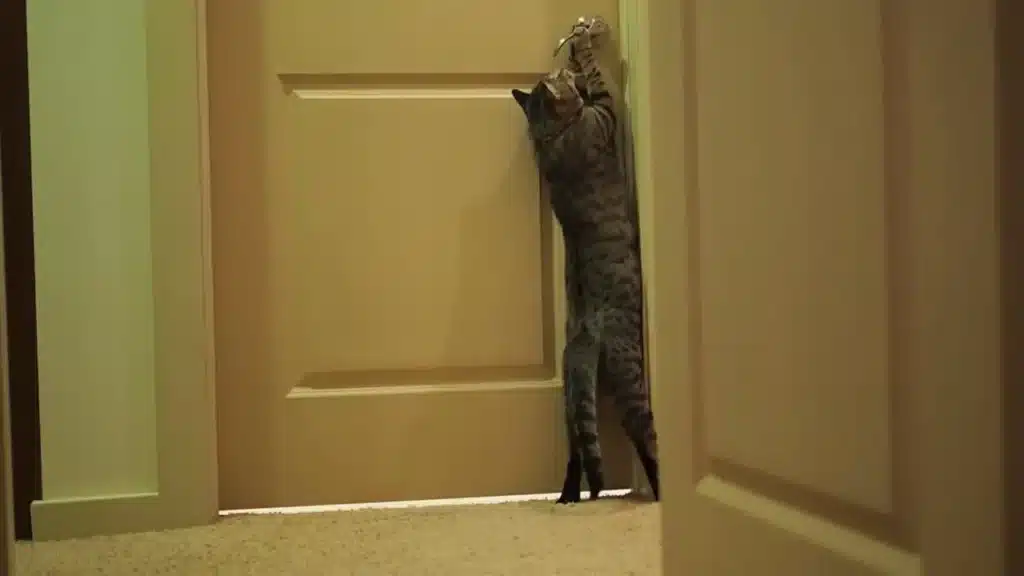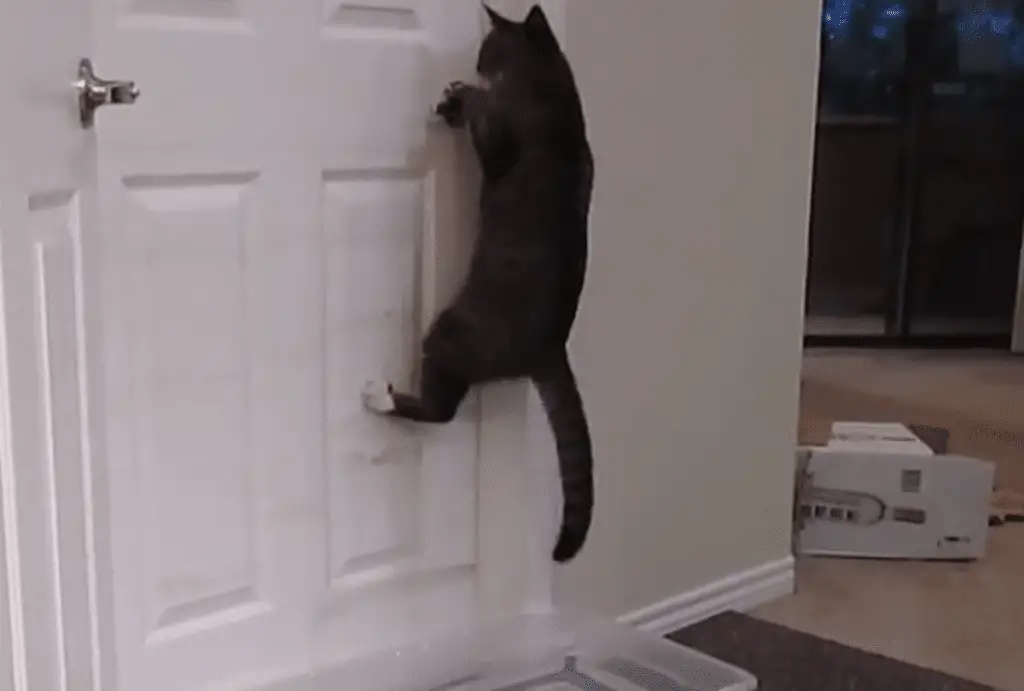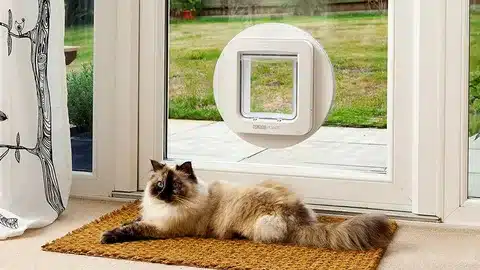Introduction
How To Install A Cat Door: Installing a cat door can provide your feline friend with the freedom to come and go as they please while maintaining your control over their access. Whether you’re aiming to give your cat access to the outdoors or designate certain areas of your home as cat-friendly zones, installing a cat door can be a practical and convenient solution. This guide will walk you through the basic steps to install a cat door, ensuring a seamless and secure transition for both you and your pet.
Gather Materials
Before you begin, gather all the necessary materials. You’ll typically need a cat door kit, a measuring tape, a pencil, a jigsaw or reciprocating saw, a drill with appropriate bits, screws, and a screwdriver. Make sure you choose a cat door that fits the size of your cat and is suitable for the location you have in mind.
Choose the Location
Select a suitable location for the cat door. Consider factors like your cat’s comfort and safety, as well as your own preferences. Most black cat doors are installed in exterior doors, interior doors leading to designated areas, or even walls. Keep in mind any obstructions or potential hazards in the area.
Measure and Mark
Using a measuring tape, mark the desired height of the cat door on the door or wall. Take into account your cat’s size and where they can easily reach. Use a pencil to draw an outline of the cat door frame, following the manufacturer’s instructions for proper dimensions.

Can I install a cat door myself?
If you know your way around a measuring tape, drill, and jigsaw, installing a pet door in an exterior wood door is a very doable DIY project. Pet doors typically come with paper templates and complete instructions on how to position the door and install it.
Can I Install a Cat Door Myself? A DIY Guide
Introducing a cat door into your home can be a game-changer, offering your feline friend the freedom to come and go as they please. If you’re wondering whether you can install a cat door yourself, the answer is a resounding yes! With a bit of preparation, the right tools, and a willingness to follow a few steps, you can embark on this DIY project and provide your furry companion with an independent and convenient way to explore the world outside—or certain areas inside—your home.
The DIY Advantage
Installing a cat door on your own not only saves you money but also empowers you to customize the experience for both you and your pet. With a variety of cat door options available, from traditional flaps to more advanced electronic models, you have the flexibility to choose what suits your cat’s needs and your home’s layout.
Preparation is Key
Before you start, gather the necessary materials, including a cat door kit, measuring tape, pencil, jigsaw or reciprocating saw, drill with appropriate bits, screws, and a screwdriver. Make sure you choose a cat door that fits your cat’s size and the location you have in mind, whether it’s a door or a wall.
Can you put a cat door on any door?
Cat flap doors can be installed in all sorts of places. Maybe you want one on your garage door, laundry room door or closet door to give them access to their cat food or litter box (or keep your feline friends from fighting over the cat food or litter box).
Door Material and Structure
The feasibility of installing a cat door largely depends on the material and structure of the door you have in mind. Solid wood, hollow core, and some metal doors are typically suitable for cat door installation. However, doors made of glass, steel, or composite materials may present challenges due to their rigidity and potential for shattering or splintering.
Door Thickness
Cat doors are designed to fit doors within a certain thickness range. Standard cat doors are usually compatible with doors ranging from 1 ¼ inches to 2 inches in thickness. If your door falls outside this range, you might need to consider alternative solutions or modify the door to accommodate the cat door.
Location and Purpose
Before installing a cat door, consider the door’s location and purpose. Interior doors leading to designated cat-friendly areas, such as a laundry room or a playroom, are generally good candidates for cat doors. Exterior doors offer your cat access to the outdoors, but they also need to provide adequate security and insulation. Make sure the chosen door and location align with your cat’s safety and comfort.
Door Traffic and People
Another factor to consider is the amount of human traffic through the door. If the door is frequently used by family members, guests, or pets other than your cat, installing a cat door might lead to disruptions, unwanted escapes, or even accidents. It’s important to assess the door’s usage patterns and potential impacts on your household.
Can a cat door be installed through a wall?
Note: The pet door can be installed in most walls. Additional tools and materials, such as wood framing, may be needed.
Feasibility of Wall Installation
Installing a cat door through a wall is possible, but it requires careful planning and execution. Unlike installing a cat door on a door itself, this method demands working with the structural integrity of your home. If you’re not comfortable with DIY projects or unfamiliar with construction techniques, it’s advisable to seek professional assistance to ensure the project’s success.
Process Overview
1. Select the Location: Choose a suitable location for the cat door within the wall. Consider your cat’s safety, the aesthetics of your home, and the ease of access.
2. Check for Obstructions: Before making any cuts, carefully inspect the wall for electrical wires, plumbing, and structural components. Avoid cutting into load-bearing walls, as this could compromise the integrity of your home.
3. Mark the Opening: Use a measuring tape and a level to mark the dimensions of the cat door opening on the wall. Make sure to follow the manufacturer’s instructions for accurate measurements.
4. Cut the Opening: Use a jigsaw or reciprocating saw to cut the opening in the wall. Take your time and make precise cuts. It’s important to create a clean and even opening to ensure the cat door fits securely.
5. Frame the Opening: Install framing around the opening to provide structural support and prevent the wall from weakening. This step might involve adding studs or framing lumber to maintain the wall’s stability.
6. Assemble the Cat Door: Follow the manufacturer’s instructions to assemble the cat door components, including the frame, flap, and locking mechanisms.
7. Insert the Cat Door: Gently insert the cat door into the opening and secure it in place by following the manufacturer’s guidelines for screwing or fastening.
8. Finishing Touches: Depending on the cat door’s design, you might need to apply caulk or weatherstripping to create a snug fit and prevent drafts.
Are cat doors safe?
Generally speaking, cat flaps are completely safe. A cat flap is too small for a human to fit through, so the only precaution you should take to ensure cat flap safety is to always remove your key from the door.
Benefits of Cat Doors
Cat doors provide numerous benefits, such as enabling cats to explore the outdoors, exercise, and fulfill their natural curiosity. Indoor cats can benefit from cat doors leading to specific rooms, reducing their dependency on human intervention for access. However, ensuring the safety of your cat while using these doors requires careful consideration.
Safety Considerations
Security from Other Animals: Cat doors can become entry points for unwanted visitors, including other animals. Stray cats, dogs, raccoons, or even larger predators might attempt to use the door, leading to potential conflicts or danger for your pet.
Home Security: Cat doors could provide access for intruders, compromising your home’s security. Some modern cat doors feature electronic locking mechanisms that can mitigate this risk.
Environmental Hazards: Depending on the location of your home, outdoor cat doors might expose your pet to environmental hazards like extreme weather conditions, traffic, or toxic plants.
Escape Risk: If not secured properly or if the door is too easy to open, some cats might accidentally push their way out, leading to potential dangers in the outside world.
Are cat doors a good idea?
For example, a cat door can allow your cat to access their cat litter box without being disturbed by a nosy dog. A small door can also provide a valuable escape route for a cat, while preventing a larger pet from passing through. Cat doors are also useful for introducing a new pet to your household.
The Pros of Cat Doors
Freedom and Independence: Cat doors grant your cat the freedom to explore the outdoors or designated areas of your home without requiring your constant assistance. This independence can improve their mental and physical well-being.
Exercise and Stimulation: Outdoor cat doors encourage exercise and mental stimulation. Cats can indulge their natural hunting instincts and explore their surroundings, reducing the risk of boredom-related behaviors.
Reduced Litter Box Dependency: If your cat has access to the outdoors, they may relieve themselves outside, potentially reducing the maintenance of the indoor litter box.
Convenience for You: Cat doors spare you the hassle of opening and closing doors for your cat constantly, especially if they have an affinity for moving in and out frequently.
Safe and Controlled Environment: Cat doors leading to safe outdoor spaces allow your cat to enjoy fresh air and sun while still being protected from potential dangers like traffic and predators.
Can cat doors be locked?
Many cat doors have a lock or, in the case of some SureFlap cat doors, a curfew mode that enables the door to be set to lock and unlock at the same times each day.
Benefits of Locking Cat Doors
Enhanced Security: Locking mechanisms offer an additional layer of security, preventing unwanted animals, pests, or potential intruders from entering your home.
Controlled Access: Locking cat doors give you control over when and how your cat uses the door. This is particularly useful during nighttime hours or when you want to keep your cat indoors for any reason.
Environmental Protection: Locking mechanisms can help protect your home from drafts, rain, or extreme weather conditions, ensuring your cat’s comfort and safety.
Reduced Noise: Locking mechanisms can minimize the noise caused by the door’s movement, especially during windy conditions or if your cat tends to use the door frequently.
Customization: With locking options like 4-way locks, you can customize your cat’s access to suit your schedule and their needs.
What are the cons of cat doors?
As convenient as pet doors can be, they may disconnect pet owners from their pets. People may feel they don’t need to spend the time in the yard or walking the animal, and that can adversely affect the bonds between pet owner and pet. Another potential disadvantage concerns alpha-driven pets.
Security Concerns:
One of the primary concerns associated with cat doors is the potential compromise of home security. Cat doors can serve as entry points for intruders, ranging from curious animals to potential burglars. Particularly in urban or densely populated areas, an unsecured cat door can become an open invitation for unwanted guests. To mitigate this risk, opting for a cat door with advanced locking mechanisms, such as microchip or magnetic locks, can provide an additional layer of security.
Environmental Hazards:
Cat doors leading to the outdoors expose your feline companion to a range of environmental hazards. Depending on your location, your cat might encounter extreme weather conditions, toxic plants, aggressive animals, or even busy roads. Outdoor cat doors can expose your pet to the risk of accidents, injuries, or encounters with contagious diseases from other animals. To address these concerns, it’s crucial to evaluate the safety of the outdoor environment and provide supervision when needed.
Unwanted Visitors:
Cat doors can inadvertently become an entry point for other animals. Stray cats, dogs, raccoons, or other wildlife might attempt to use the door, potentially leading to conflicts, territorial disputes, or even harm to your pet. To prevent such situations, consider cat doors with selective access mechanisms, such as microchip locks, which only allow authorized animals to enter.
Noise and Disturbance:
Cat doors can generate noise as they swing back and forth, potentially causing disruptions, especially if your cat is active during the night. This could disturb your sleep or the quiet of your household. To address this, look for cat doors that are designed to minimize noise, or consider alternative options like supervised outdoor play during specific times.
Training Effort:
Introducing your cat to a cat door might require some training effort. Not all cats will intuitively understand how to use the door, and they might need guidance and encouragement in the beginning. Patience and consistency are key when training your cat to become comfortable with the door.
Should I open the door for my cat at night?
Leaving a cat outside all night is extremely risky. Many large predators are out at night, and your cat is in danger. I would encourage you to keep your cat indoors, and at the very least bring it inside before darkness falls. Leaving the cat door open is an invitation to trouble.
The Cons of Opening the Door at Night
Safety Concerns: Allowing your cat outside at night exposes them to a variety of risks, including encounters with other animals, traffic, and even predators. Assess the safety of your environment before deciding to keep the door open at night.
Environmental Hazards: Nighttime might bring different hazards, such as colder temperatures or increased humidity, which could impact your cat’s comfort and health.
Unwanted Visitors: Opening the door at night can invite unwanted guests into your home, including wildlife or other cats. This could lead to conflicts, territorial disputes, or health concerns.
Disturbance to Others: If you live with other people or have neighbors in close proximity, the coming and going of your cat at night might create noise disturbances.
Factors to Consider
Location: The safety of your location plays a significant role. If you live in a quiet neighborhood with minimal traffic and predatory animals, the risks might be lower.
Supervision: If you’re comfortable and able to supervise your cat’s activities at night, it could be safer to let them roam. However, this might not be feasible for all pet owners.
Alternative Play: If you’re concerned about your cat’s activity at night, consider providing engaging indoor playtime during the evening to help them expend energy.
Indoor Enrichment: Investing in interactive toys, scratching posts, and climbing structures can keep your cat mentally stimulated and physically active, even during the night.

Conclusion
Installing a cat door is a rewarding project that grants your feline friend the freedom to move in and out of designated areas while maintaining your control over their access. By following the steps outlined in this guide, you can ensure a successful installation process:
Preparation: Gather all necessary materials and choose a suitable location for the cat door, taking into consideration your cat’s safety and your preferences.
Measurement and Marking: Accurately measure and mark the desired location of the cat door, using a pencil to outline the frame dimensions as per the manufacturer’s instructions.
Cutting the Opening: Carefully use a jigsaw or reciprocating saw to cut along the marked outline, whether it’s on a door or wall. Prioritize safety by wearing appropriate gear.
Assembling the Cat Door: Follow the manufacturer’s instructions to assemble the cat door components, ensuring the frame, flap, and locking mechanisms are securely attached and functioning properly.
Installation: Place the assembled cat door into the opening, align it correctly, and drill holes for screws. Then, secure the cat door by inserting and tightening the screws.
Testing and Adjustment: Encourage your cat to use the door and provide them with guidance if needed. Adjust the tension of the flap or locking mechanisms as required to ensure your cat’s comfort.
Monitoring: Observe your cat’s interaction with the new door, making any necessary modifications to enhance their ease of use.
By installing a cat door, you’re enhancing your cat’s quality of life and granting them the ability to explore their surroundings while maintaining a level of control. This project not only benefits your feline companion but also contributes to the convenience and harmony of your home environment. Remember to prioritize safety, take your time, and enjoy the satisfaction of creating a secure and functional access point for your beloved cat.





No Comments